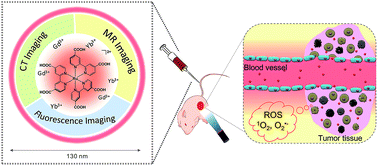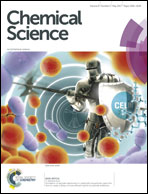Multifunctional mixed-metal nanoscale coordination polymers for triple-modality imaging-guided photodynamic therapy†
Abstract
The one-step self-assembly preparation of multifunctional gadolinium (Gd)–ytterbium (Yb) mixed-metal nanoscale coordination polymers (NCPs) with Ru[4,4′-(COOH)2bpy]32+ (LRu, bpy = bipyridyl) as a ligand is reported. The Gd/Yb ratio in the NCPs is easily tuned by their ratio in the precursors while the self-limiting growth is realized with the high coordination valence and rigid steric structure of the precursors. The inherent properties of the precursors, including the magnetic resonance (MR) response of Gd3+, the X-ray attenuation properties of Yb3+, and the red fluorescence and the singlet-oxygen generation of LRu, are well retained in the mixed-metal NCPs. In vivo fluorescence-MR-X-ray computed tomography (CT), triple-modality imaging and photodynamic therapy (PDT) are achieved using the mixed-metal NCPs as a probe. The triple-modality imaging integrates the high sensitivity of red fluorescence imaging, the deep penetration of MR imaging, and the 3D spatial resolution of CT imaging, thus providing comprehensive and complementary imaging information and facilitating the efficient imaging-guided PDT. For the first time, triple-modality imaging and a PDT agent were prepared with an easy and robust procedure, a tunable mixed-metal ratio, a high yield, and endogenous signal units.

- This article is part of the themed collection: Celebrating 100 Years of Chemistry at Nankai University


 Please wait while we load your content...
Please wait while we load your content...